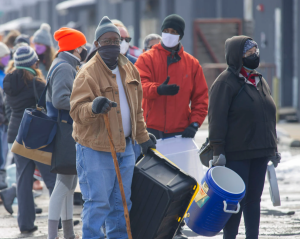Empathetic leadership during the storm
 “Lead with an iron fist,” said some.
“Lead with an iron fist,” said some.
“Never let them see you cry,” others recommended.
“You were born to lead,” many affirmed.
Countless people have offered advice and encouragement to me as a leader over the years. Yet the idea of empathetic leadership has rarely been addressed.
As a Black female nonprofit executive in Texas who earlier this winter found herself in a vulnerable moment, I feel compelled to record some of my struggles. First there was the pandemic, followed by the killing of George Floyd and heightened racial tensions, and then — boom! — a winter storm with near-zero temperatures that collapsed the state’s power grid and left millions of Texans in dark, unheated homes. Even as it was happening, I knew it was going to be bad, and most likely deadly.
My first instinct was to reach out to my staff and inquire about their housing, food, and other needs. In my experience, employers in times of crisis rarely do wellness checks on their employees (other than to inquire whether the employee will be coming into work or not). While nonprofits are quick to respond to community needs during a disaster, how many organizations offer direct support to their own staff? As an empathetic leader, I was concerned first and foremost that those closest to me were safe and out of harm’s way.
During the deep freeze, I considered my teams’ mental health and reminded them of our EAP program and insurance plans that could assist with counseling. With a team comprised largely of women of color, I understood how responses to crisis and trauma live in our bodies. But in my role as executive director of Faith in Texas, I also knew I had to consider all the harms suffered by the communities my organization serves.
Where did that leave me? Self-care seems to be the rage these days, but it’s much easier said than done. Infuriated by the lack of accountability on the part of Texas officials, ERCOT, and electric companies serving the state, I decided to take a break from the news. But within an hour, an employee texted me asking if we could help dozens of families that had been locked out of their hotel rooms and had nowhere to go.
It was then that the magnitude of the crisis became apparent. This wasn’t a time for self-care. As a single mother, my heart ached for the displaced mothers and their children. I imagined them trying to survive the freezing cold, dealing with harsh conditions as they scrambled to find public transportation to the suburbs, where mutual aid groups could secure them rooms. I imgained them trying to find food to eat, water to drink, hygiene products, even underwear for themselves and their kids.
It was more or less the same thing the employee who texted me was experiencing. A Black woman and mother of small children, she, too, was scrambling to find temporary housing. And yet she was advocating for others in crisis; self-care would have to wait.
In the days that followed, family and business colleagues from around the country reached out to check on me and my sons. And my answer to their first question was always, “I’m fine. Grateful to be safe, warm and healthy.” But I was numb.
Through my contacts, I began to hear about helpers on the front lines — heroic individuals, small nonprofits, and local Black churches that were doing crucial, in-the-moment work to help people survive. I knew their names wouldn’t be mentioned during funder calls. And while local and national media outlets were making an efort to highlight the work they were doing and individuals around the country were responding to calls for donations, I realized I had a responsibility to elevate all the organizations and people who were selflessly neglecting their own self-care to provide critical services. Truth be told, I wasn’t sure if every organization had 501(c)(3) status, but that hardly seemed to matter. They needed — and deserved — all the resources they coud get. And they deserved to be trusted to use the money — not just in-kind donations — in an effective manner. Standing up for grassroots organizations is another role I embrace.
Leading with empathy probably isn’t the best long-term strategy for a Black female nonprofit executive looking to impress large funders and donors, but, inspired by John Hope Bryant’s Love Leadership, it’s the legacy I prefer to leave. Like Bryant, I recognize that there can be no strength without suffering, no power without vulnerability. As Black women calling for equity and healing, my sisters and I speak out of love and respect, from a history of suffering, and mindful of our own vulnerability. All we ask is that you give us an opportunity to show our greatness.
This article originally appeared in the Opinions section of Women of Color in Fundraising and Philanthropy.






